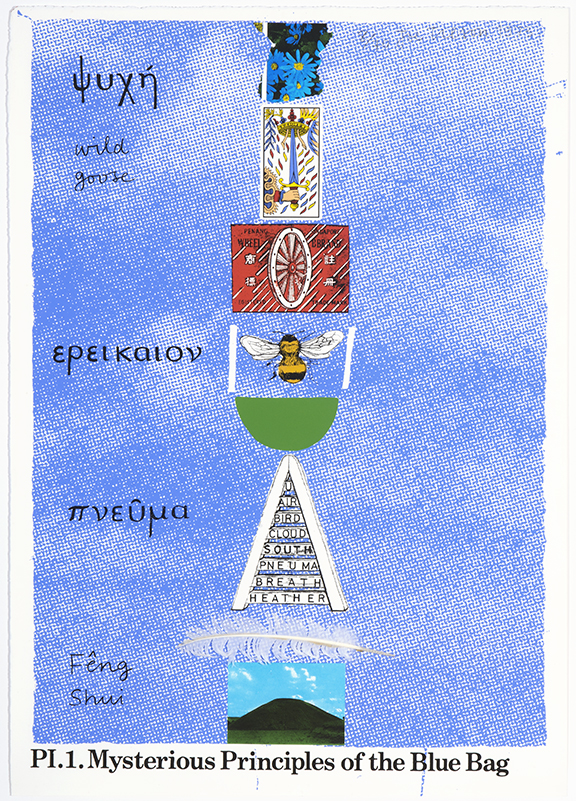(b. 1928)
Located in hallway LY 101.3 (Dr. Archer Library building, 1st floor)

Photograph by the University of Regina.
Joe Tilson
Pl. 1 Mysterious Principles of the Blue Bag (8/70), 1973
Silkscreen serigraph, mixed media, collage
40” x 28”
pc.1975.6
Joe Tilson is synonymous with the early Pop Art movement in 1960’s London. He studied at the prestigious St. Martin’s School of Art (later teaching there) and the Royal College of Art. His major breakthrough came through representing Great Britain at the Venice Biennale in 1964, an event that brought major figures in Pop together from across the globe. He remains associated with such artists as Peter Blake, R.B. Kitaj and David Hockney, whom he knew and exhibited with.
However, during the 1970’s, his work turned away from Pop and its fascination with urbanity and consumerism. After leaving London for a more rustic lifestyle, he utilised his woodworking skills to produce wood reliefs and sculptures in addition to prints. Pl. 1 Mysterious Principles of the Blue Bag emerged from the Alchera series (1970-76) of that period. In the lower section, the print features a representation of Air Ladder, a large triangular wooden sculpture Tilson crafted in 1971. Pl. 1 Mysterious Principles of the Blue Bag and Air Ladder embody tenets central to Tilson’s post-Pop interests; his admiration for craftsmanship, traditional handiwork, rural life, nature and the elements.
Alchera, referring to the Australian Aboriginal concept of dreamtime, featured work riddled with incantation-like compositions of words and symbols. Explicit or suggested references to elemental metals, the seasons, the zodiac and earth, air, fire and water appear in totemic or diagrammatical constellations. Feeding Tilson’s personal rhetoric were the great thinkers and poets of history: Carl Jung, William Wordsworth, Heraclitus and other Greek philosophers. This new direction in his work was seen publically at the eponymous 1973 exhibition at the Boymans-van Beuningen Museum, Rotterdam. In the catalogue, Curator R. Hammacher-van den Brande wrote: “[Tilson] invokes the old values in order to restore links that can amplify and liberate his spirit, which is essentially modern, and his creations, which are unequivocally of our own day”.


